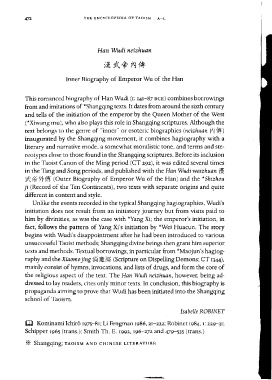Page 512 - The Encyclopedia of Taoism v1_A-L
P. 512
THE ENCYCLOPEDIA OF TAOISM A-L
Han Wudi neizhuan
Inner Biography of Emperor Wu of the Han
This romanced biography of Han Wudi (r. 141-87 BCE) combines borrowings
from and imitations of *Shangqing texts. It dates from around the sixth century
and tells of the initiation of the emperor by the Queen Mother of the West
(*Xiwang mu), who also plays this role in Shangqing scriptures. Although the
text belongs to the genre of "inner" or esoteric biographies (neizhuan lA] 1~)
inaugurated by the Shangqing movement, it combines hagiography with a
literary and narrative mode, a somewhat moralistic tone, and terms and ste-
reotypes close to those found in the Shangqing scriptures. Before its inclusion
in the Taoist Canon of the Ming period (CT 292), it was edited several times
in the Tang and Song periods, and published with the Han Wudi waizhuan 1l
:itWf ,yHw (Outer Biography of Emperor Wu of the Han) and the *Shizhou
ji (Record of the Ten Continents), two texts with separate origins and quite
different in content and style.
Unlike the events recorded in the typical Shangqing hagiographies, Wudi's
initiation does not result from an initiatory journey but from visits paid to
him by divinities, as was the case with *Yang Xi; the emperor's initiation, in
fact, follows the pattern of Yang Xi's initiation by *Wei Huacun. The story
begins with Wudi's disappointment after he had been introduced to various
unsuccessful Taoist methods; Shangqing divine beings then grant him superior
texts and methods. Textual borrowings, in particular from *Maojun's hagiog-
raphy and the Xiaomo jing ~~ !I ~~ (Scripture on Dispelling Demons; CT 1344),
mainly consist of hymns, invocations, and lists of drugs, and form the core of
the religious aspect of the text. The Han Wudi neizhuan, however, being ad-
dressed to lay readers, cites only minor texts. In conclusion, this biography is
propaganda aiming to prove that Wudi has been initiated into the Shangqing
school of Taoism.
Isabelle ROBINET
m Kominami Ichiro 1975-81; Li Fengmao 1986, 21-222; Robinet 1984, I: 229-31;
Schipper 1965 (trans.); Smith Th. E. 1992, 196-272 and 479-535 (trans.)
* Shangqing; TAOISM AND CHINESE LITERATURE

